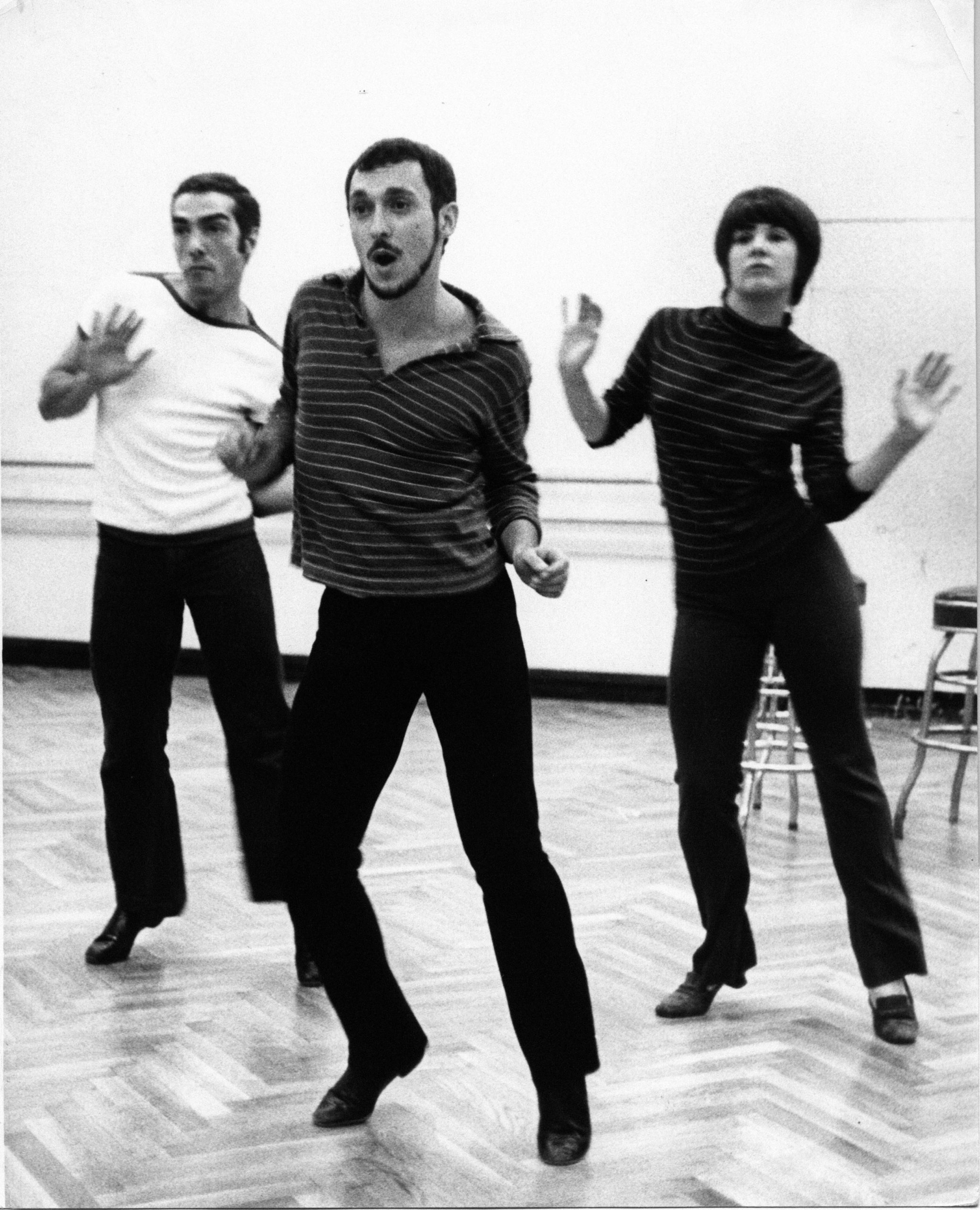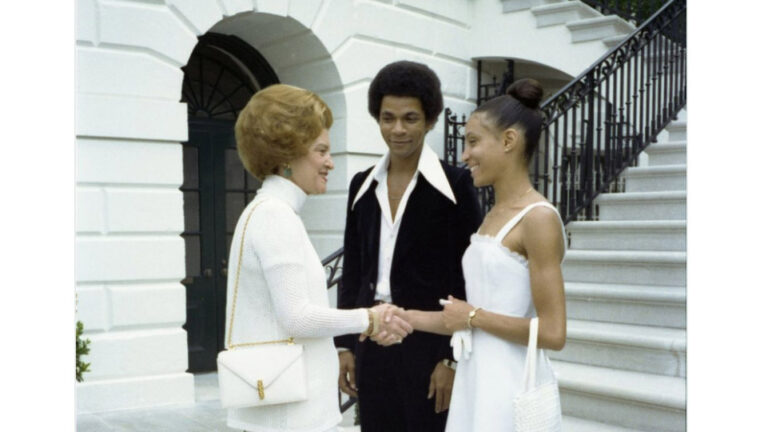
A dancer’s ornamentally unfurling arms and catlike spine develop under a spotlight. Alone in a dark, empty space, she watches her haloed dancing figure in a mirrored triptych, whose three panels resemble a church altar painting. In this iconic “Music and the Mirror” number of A Chorus Line, director Michael Bennett revealed a dancer’s private sanctuary: the dance studio. In the longest-running Broadway show of its time, Bennett exposed dancers’ courageous plight through pathos-infused monologues and plaintive song—without sexing up or satirizing their lives. The musical’s intimate subject, what it feels like to put oneself on the line, was revolutionary. Though Bennett directed and choreographed 10 musicals (and earned seven Tony Awards for best choreography or direction), it was through A Chorus Line that he changed musical theater history.
Bennett believed Broadway audiences deserved more than fairy tales and high production values, and with A Chorus Line, he created the first musical vérité, a documentary-style production based on 24 hours of recorded conversations of dancers frankly discussing their lives. He modeled himself after Jerome Robbins, crafting historically and psychologically realistic characters, using existing dance styles to reflect an individual’s world. He gave a new generation of dancers valuable work that resonated with their own experiences.
Michael “Bennett” DiFiglia was born and raised in Buffalo, New York. At age 2, his mother enrolled him in dance classes, and at age 11, he saw his first Broadway show, Bob Fosse’s The Pajama Game. He went pro five years later, playing Baby John in the touring production of Jerome Robbins’ West Side Story. Dropping out of Bennett High that year, the newly christened Bennett told reporters his name change was recompense for never finishing school.
Bennett landed his first Broadway gig as a dancer in Subways Are for Sleeping, but his real knack was for creation. At 20, he served as choreographic assistant to Ron Field in Nowhere to Go But Up, and it was in that period that he met Robert Avian, who would become his longtime collaborator. The duo first teamed up to choreograph Henry Sweet Henry in 1967, which, although it was a flop, earned a Tony nomination for best choreography. “Our styles ended up playing off each other,” said Avian, “my training in classical and ballet, his in jazz and tap.” Their sentiments were also complementary: Bennett could be cutting with dancers; Avian knew how to salvage relationships. The pair worked together on nine subsequent Broadway productions, including Tony winners Promises, Promises, Company, Follies, Seesaw, A Chorus Line and Dreamgirls.

Despite Bennett’s successes, the Broadway scene of the early 1970s was floundering. But in 1974, musical theater would change forever. In January, Broadway dancer Michon Peacock invited him to a rap session that she organized along with dance veteran Tony Stevens. They felt dancers were being taken advantage of by directors and producers. “We decided we had to do something to change the status of dancers,” says Peacock. She and Stevens wanted to form a Broadway dancer-based repertory company, and they used Bennett’s star power to attract participants.
“Michael Bennett is going to be there and we’re going to dance,” Stevens told the dancers. “It’s going to be a marathon. We’re going to stay up all night, talk about life and what it’s like to be a dancer.” After Stevens led a dance jam, Bennett initiated the conversation. He also brought a tape recorder.
These workshops were originally called “The Dancer Project,” and with New York Shakespeare Festival director Joe Papp’s backing of $100 a week for each dancer and the use of a black box theater, Bennett continued rehearsals. He brought Marvin Hamlisch, an Oscar Award–winning composer, on board. As the workshop evolved, the 19 dancers (10 from the original session) were stretched to their psychological limits. “Can you imagine people auditioning for their own life stories?” says A Chorus Line original Cassie (and briefly Bennett’s wife) Donna McKechnie. Bennett didn’t just create a musical about an audition; he made rehearsals into nearly constant auditions for dancers whose parts were based on their lives. The musical’s story, lyrics, design and choreography were created through exhaustive revisions and collaborations through what is now called the workshop production.
When A Chorus Line premiered in the 299-seat black box theater, it became an immediate sensation and moved to Broadway. It had a gut-level authenticity and a harrowing intensity, and its message of determination and triumph resonated not only with dancers in the audience, but also with the general population, says dancer Leslie Woodies, who played Cassie in the New York Shakespeare Festival production. “I remember people would wait 30 or more minutes by the stage door to tell us their stories,” she says. “Even years later, when I was in On Your Toes, a woman who read Cassie in my bio, waited to tell me that after watching A Chorus Line, she found the courage to leave an abusive husband. The production presented such a broad range of human experience.”
After A Chorus Line, reviews of Bennett’s next musical, Ballroom, were mixed, but Dreamgirls (1981) was a hit. It brought the subject of race to Broadway through a tale about three black backup singers. And in 1985 Bennett pushed Broadway’s culturally conservative envelope further with the musical Scandal. But when Bennett was diagnosed with AIDS, he stopped production, telling the writer Treva Silverman, “What will the critics say about a show about sex whose director is dying of AIDS?”
When Bennett died two years later at the age of 44, “he left a Grand Canyon–sized gap in the musical theater community,” says Woodies. The night of Bennett’s death, the cast of A Chorus Line changed the pronoun of the final song from “She” to “He’s the…One!” Broadway was forever changed. Choreographers today, including Jerry Mitchell, credit Bennett as their greatest influence, and one can only image what he could have accomplished. “He was incredibly smart,” says Peacock. “You never knew what Michael was going to do next; he was endlessly creative.”
Now, test your students’ knowledge with this Michael Bennett history quiz!
Fast facts
- When A Chorus Line premiered at The Public Theater in New York, Henry Fonda, Jacqueline Kennedy Onassis, Mikhail Baryshnikov and Diana Ross attended.
- With the success of A Chorus Line, Bennett purchased the NYC building at 890 Broadway in 1978. Today, it’s home to production and dance companies, including American Ballet Theatre and Ballet Tech.
- Bennett received the 1976 Dance Magazine Award; for A Chorus Line, he won two Tonys, two Drama Desk Awards and the 1976 Pulitzer Prize.
- A Chorus Line was made for a little more than $1 million. Thirteen years later, in 1988, its gross earnings totaled $260.4 million.
- A Chorus Line has been produced and staged in six languages.
- Bennett bequeathed 15 percent of his estate to AIDS research.
Books
- Avian, Bob and Tom Santopietro. Dancing Man: A Broadway Choreographer’s Journey. University Press of Mississippi, 2020.
- Mandelbaum, Ken. A Chorus Line and the Musicals of Michael Bennett. St. Martins Press, 1989.




